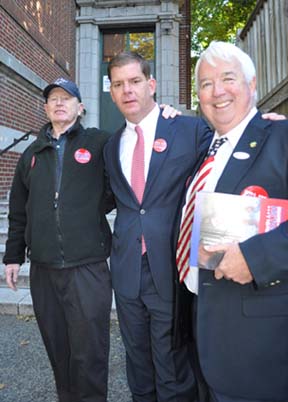September 25, 2013
Rep. Marty Walsh’s strong first-place finish in Tuesday’s preliminary election came as a surprise to most observers — mainly because pre-election day polls had Walsh finishing second to City Councillor John Connolly.
There’s another reason why Walsh’s election-day performance may have been underestimated: The Savin Hill native has not been personally tested at the ballot box in any meaningful way since 1997, when he prevailed in a special election to win his 13th Suffolk House seat.
In that race, Walsh wrestled against a tough field – which included current state Attorney General Martha Coakley. His deep union bench, coupled with his strong and undiluted base in Ward 13— made the difference in his rookie outing.
 Walsh in his home base: The candidate with two key Savin Hill supporters working the polls outside Cristo Rey School. Left, Danny Ryan. Right, Roger Croke. Photo by Bill ForryWalsh has since helped many other candidates win elections (including John Connolly and other opponents on Tuesday’s mayoral dance card whom he’s leaned in for in past cycles.) But he hasn’t had to flex his own muscles much, running unopposed in nearly every election since he won the seat. So there was that question mark in the run-up to the preliminary vote:
Walsh in his home base: The candidate with two key Savin Hill supporters working the polls outside Cristo Rey School. Left, Danny Ryan. Right, Roger Croke. Photo by Bill ForryWalsh has since helped many other candidates win elections (including John Connolly and other opponents on Tuesday’s mayoral dance card whom he’s leaned in for in past cycles.) But he hasn’t had to flex his own muscles much, running unopposed in nearly every election since he won the seat. So there was that question mark in the run-up to the preliminary vote:
Just how good will Marty’s ground game be in Dorchester and South Boston?
Team Walsh answered that innocent query with the subtlety of a bagpipe-infused Dropkick Murphy’s anthem.
There wasn’t a piece of union sheetrock going up anywhere near the city of Boston on Tuesday. Just about every able-bodied, Timberland-wearing hard-hat from Somerville to Scituate was in his red Marty shirt for stand-out duty by the morning rush hour, dominating intersections across the city’s southern seacoast.
By 3 p.m., you couldn’t turn a corner in Pope’s Hill or Cedar Grove – or in South Boston’s two wards – without crossing paths with a two-person canvass team. Walsh’s camp says they deployed upwards of 1,500 bodies for a “blind pull” aimed at rousting tardy voters in his House district.
He racked up lopsided margins in the places he needed to: His home precinct at Savin Hill’s Cristo Rey School dropped a cool 500 into his kitty to start. Florian Hall’s two precincts doubled that total and helped him run up the score in a section of the neighborhood where his other Dorchester neighbors just could not compete. South Boston was very good to Marty, who beat out his closest competition— John Connolly—by three-to-one margins in many spots.
To say that Marty Walsh won Dorchester might be technically true (we’re still poring over those stats), but it wouldn’t fully explain what happened across the whole neighborhood. Without question, Walsh dominated in his House district— often mining up to 75 percent of the votes in Neponset and Columbia-Savin Hill.
But Charlotte Richie and John Barros – generally in that order – took all of the precincts in communities of color. Barros carried the Strand Theatre, the Ward 15 precinct where he votes, and other nearby polling stations, like the Annapolis Street Apartments in Ward 13 and Bowdoin Street’s Pasciucco Apartments where his Cape Verdean base was notable. Richie prevailed most everywhere else – including farther-flung precincts like the Chittick School on the Mattapan/Hyde Park line. Richie’s third-place finish will undoubtedly be deconstructed with an eye toward assigning spoiler blame to one or another candidate who shared her minority base. For example, if you totaled the final results for Charles Yancey and Charles Clemons, who finished far down the list, and apportioned all of their votes to Richie, she would have surpassed Connolly and made it into the November run-off. But such an exercise is fraught with presumptions about voter intent. How many of those votes would have swung to Arroyo instead of Richie? How many to Barros? It’s unknown and likely unknowable.
More germane to the next phase of this contest is the fact that both Walsh and Connolly were often next in line after Richie and Barros across communities of color. For example, Connolly and Walsh – in that order – finished third and fourth at the double-precinct Morning Star Baptist Church on Blue Hill Avenue, surpassing minority candidates like Arroyo, Yancey, and Clemons. Walsh placed second to Richie in mixed precincts like the Lower Mills and Codman Square libraries and the Codman Square Tech Center— close to his House seat, but not in it.
Neither Walsh nor Connolly will be able to brag about winning communities of color— but each has the makings of a base to build on. That’s especially encouraging for Walsh, who has never been on the ballot at Morningstar Baptist— or anywhere else outside of his House district.
There hasn’t been a Dorchester mayor since Codman Hill’s John B. Hynes passed the City Hall keys off to John F. Collins in 1960 – mainly because the city’s largest neighborhood has also been the most fragmented – especially along racial lines. No Dorchester candidate has been able to cobble together the kind of coalition it takes locally— or city-wide— to clear that final hurdle to the Fifth Floor.
The ultimate fate of Marty Walsh’s candidacy will hinge on whether or not he can re-wire that historical current and attract voters of color into his column. John Connolly will be making the same play. Who’ll get it done? We’ll see you on the night of November 5.
Topics:


